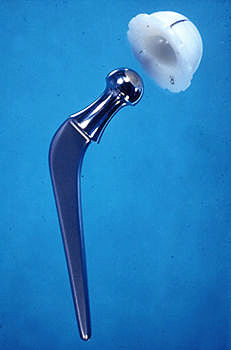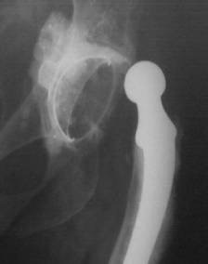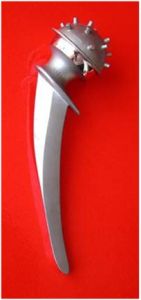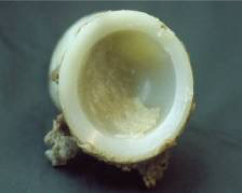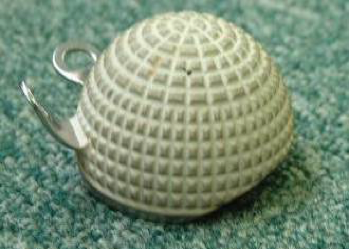The History of the Dual Mobility Cups
It was in 1974 that Professor Gilles BOUSQUET started thinking about the potential outcomes of the dual mobility cups. Back then, the situation was more or less as described below:
Firstly, we already had stems with a small 22mm femoral head in a cemented cup made of polyethylene, the CHARNELEY prosthesis.
In 1962, it was considered as the first “modern” hip prosthesis and seen as the “Gold Standard” of THAs thanks to all the advantages offered by the CHARNLEY, such as low friction and minimal wear. Its main disadvantage however was its propensity for dislocation.
Professor Gilles BOUSQUET simple idea was to combine these two advantages:
The low friction of CHARNLEY’s 22mm small head and the anti-dislocation property of the 32mm large head.
In an article published in “Maitrise Orthopédique“, Pr. Michel-Henry FESSY brought to our attention that some of the dual mobility concepts originate from CHRISTIANSEN’s ideas. In fact, this surgeon wrote an article in 1969 about his hip arthroplasty experiences, including a very original idea for an implant he had been using since 1964. The stem is secured into the femur—a Delrin piece with a large diameter interlocks into a cylindrical femoral neck. It rests on a collar on its equatorial plan. The Delrin is associated to a stainless steel cup. It can move around the neck axis while leaning against the collar. Because of the geometry of the pieces, the stainless steel cup can only move around the Delrin around the neck’s axis. This stainless steel piece articulates with the acetabulum in its intermediate version, and with the cup anchored in the pelvis in its total prosthesis version. In the 70s, some of the system’s defects were put into light. Notably, wear of the Delrin due to varus tilting around the neck’s axis and on the collar.

Here are the steps that lead Pr. Gilles BOUSQUET and André RAMBERT, Engineer and Mechanics Professor at ECAM in Lyon, to the Dual Mobility concept.
His first attempt in 1974 consisted in making a bipolar implant with polyethylene.
The main difference with a standard bipolar is that there isn’t a retaining ring and that the polyethylene is in direct contact with the bone.
The results were deceiving, as shown on this explant displaying the damages after one year of use.
Nevertheless, the concept of a free insert around a head nested inside an acetabular cavity was born.


The second attempt in 1976, consisted in adding a free metal cup lodged in between the polyethylene insert and the bone.
Unfortunately, failure happened after only a month when the metal cup completely shifted and came into conflicting contact with the prosthetic neck, shattering the metal cup into pieces.
It became obvious that the metal cup had to be fixed !



On the third try in 1977, a thicker cup was cemented into the acetabulum and the free polyethylene was encapsulated into the femoral head.
The dual cups or dual articulation was born. The year was 1977 and the invention has to be credited to Professor Gilles BOUSQUET.
After cementing the metal cup like a standard acetabular cups, Gilles BOUSQUET initially imagined a cemented tripolar attachment.
Quickly however, the necessity for a non-cemented cup was observed.



In 1979, Daniel NOYER, one of Pr. Gilles BOUSQUET’s assistant, created a non-cemented dual articulation with macrostructures and 2 tabs located on the hemisphere of the cup
Daniel NOYER is a member of the GILES group
At the same time, Pr. Bousquet, suggested a non-cemented cup which became famous in France for being the true “original” dual cup articulation with a quick tripod attachment system.
The NOVAE cup by the SERF company.
In both cases, the lining is made of alumin.
As you can see, this concept has been used in France for more than 30 years and hasn’t changed, aside from external drawings.


From a clinical perspective, dual mobility cup’s anti-luxation properties quickly became obvious
Since the first hip replacement in 1962 and the JUDET brothers’ first attempts in 1946-1948, dislocation has been a major risk in this type of surgery.
If we refer to the literature about primary procedures, a standard prosthesis has a dislocation rate varying between 1 and 9%. The dislocation rate can reach 30% in case of a revision procedure.
In fact, J. CATON and D. BERRY demonstrated in 2004 that, in addition to post-surgical dislocations, the risk of a dislocation is cumulative over the life span of the implant (tests realized over 25 years). Moreover, the national registries for THA reports confirm these observations and demonstrate that dislocations are the main reason for revisions.
In France, everyone knows of the CHU of Caen’s study reporting only one dislocation out of 1100 primary THAs and a rate lower than 4.75% for revision procedures. It must also be noted that most French surgeons use posterior approaches.
Finally, it isn’t uncommon to see patients with Pr. BOUSQUET’s prosthesis after 20 years, still in great condition.


Two French studies have confirmed the clinical impressions:
The first one came from Pr. BOUSQUET’s department in St Etienne and the second one, from Pr. AUBRIOT at the University Hospital in Caen—the only one to support this idea at the time.
Both studies were published in the RCO and describe the outcome of BOUSQUET’s cup 15 years after being implanted.
St. Etienne’s University Hospital study in February 2008 reports a survival rate of 89.2% after 15 years. Conclusions report an absence of dislocations but indicate 2 types of failures:
1) weakness of the primary cup fixation which doesn’t have a macrostructure or an HAP
2) intra-prosthetic dislocation!
The Caen University Hospital study of November 2007, known for its impartiality, shows that the Kaplan Meier survival rate for all causes after 15 years is 84.4%.
The conclusions are very similar to the study in St-Etienne:
1) Low rate of dislocation and strong long-term survival of the cup.
2) Issue with the primary attachment of the cup.
In France, a growing number of studies about the PE wear are available. The one conducted in November 2000 at the University Hospital in St. Etienne by G. Bousquet’s successor, Pr Michel-Henry FESSY, concerns 50 types of explants.
To be part of the study, the implants needed to be in place for at least 3 years. The average life time of the implants was 9 years and 2 months.
The results and conclusions of the study draw to low wear of the insert’s convex part, namely, that the measurements were always within the liner’s manufacturing tolerance limitations.
This study pointed out the same failures previously exposed.
Here’s a 19 year old explant where the machining ridges of the liner can still be observed.


Admittedly, the 1st generation dual articulations had a few failures. Not because of massive wearing of the external convex part of liner, as one would have predicted, but mainly because of wearing on the internal retentive part!
We can observe migrations of the femoral head across the PE insert once the retentive part has been eroded to an extreme. Other issues include the insert getting stuck into a position, the head passing through, or the head dislodging from the inserts and pushing against the bottom of the metal cup.


Explants have taught us a lot on the wear phenomenon.
The first cause is the shape of the femoral necks used at the time.
– extraction hole
– coarse necks
– angular necks
– massive necks (to be proscribed for dual articulations)
We also learned that the PE regularly rotates into the cup.




The 2nd cause for failures was the design of the metal cup
We have observed conflicts between the cup and the neck around the lateral edges of the cutout of of the BOUSQUET cup.
These edges combined with the weakness of the materials used for the metal cup, sometimes caused the liner to be pinched and get stuck in a fixed position.
The edges were also the cause for pain and psoas tendinitis.



Finally, if the original BOUSQUET cup held in place very well thanks to a single tripod attachment, the explants showed that the absence of a secondary osseous attachment.


After Gilles BOUSQUET’s passing in 1997, his legacy over the Dual Mobility Cups was the following
The concept of a large convex head made of PE in a pressfit metal cup was the undeniable solution to neutralize most of the encountered issues.
However, there were still imperfections and failures.
We decided to develop Bousquet’s original dual articulation cup by relying on the cumulated experience of members of the GILES group, such as Daniel Noyer and Philippe GIRARDIN, whom have been implanting dual-mobility implants since 1977.
Next chapter : The History of the Development and Conception of the Polarcup

